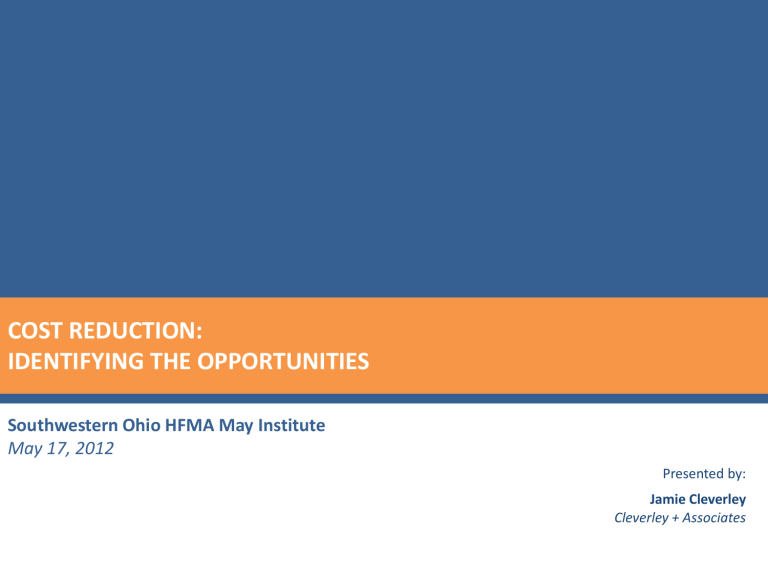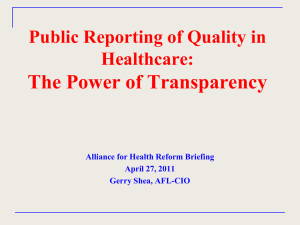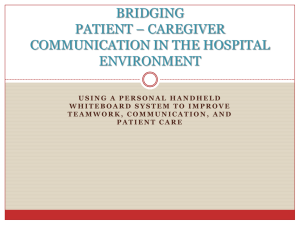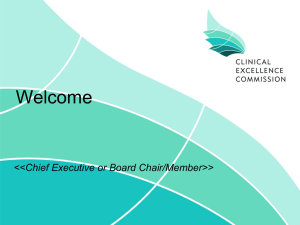Cost Reduction—Identifying the Opportunities
advertisement

COST REDUCTION: IDENTIFYING THE OPPORTUNITIES Southwestern Ohio HFMA May Institute May 17, 2012 Presented by: Jamie Cleverley Cleverley + Associates Today’s Objectives 1) Confront national healthcare cost questions a) Are we experiencing a national healthcare cost crisis? b) If there is a crisis, do I have a role and responsibility to help change it? 2) Examine characteristics of low-cost providers through a national study of US acute-care hospitals a) b) c) d) e) How big is the cost gap? Are certain demographic factors associated with higher cost? What areas do “low-cost” providers excel? Does “lower-cost” necessitate “lower-quality?” What is the impact on margin? 3) Determine a framework for cost assessment and management execution |2| CONFRONTING NATIONAL HEALTHCARE COST ISSUES Confronting national healthcare cost issues ? Are we experiencing a national healthcare cost crisis? |4| 20% 18% 6% 1966 2010 2020 Confronting national healthcare cost issues What we know: Healthcare’s % of GDP is increasing |5| National Health Expenditures (top five areas) Source: CMS Data Compendium 2011 Edition Confronting national healthcare cost issues What we know: All Healthcare segments are growing |6| Annualized Change in National Health Expenditures by Area 1980-1990 % Change 1990-2000 % Chg Drugs 12.8% Drugs Physician 12.8% Admin Priv Hlth Ins Admin Priv Hlth Ins 12.4% Nursing Home Other 2000-2009 % Chg 11.6% Drugs 8.4% 7.7% Admin Priv Hlth Ins 8.1% Other 6.1% Hospital 6.9% 11.4% Dental 7.0% Other 6.5% 11.3% Nursing Home 6.6% Physician 6.4% Hospital 9.6% Physician 6.2% Struct & Equip 6.3% Struct & Equip 9.4% Struct & Equip 5.9% Dental 5.7% Dental 9.0% Hospital 5.2% Nursing Home 5.4% TOTAL ALL 6.6% TOTAL ALL 6.8% TOTAL ALL 11.0% Source: CMS Data Compendium 2011 Edition Confronting national healthcare cost issues What we know: All Healthcare segments are growing |7| Source: CMS Data Compendium 2011 Edition Confronting national healthcare cost issues What we know: Government’s responsibility is increasing |8| Gross Public Debt as a Percentage of GDP Confronting national healthcare cost issues What we know: Government’s ability to pay is challenged |9| Context for Medicare payment policy Growing health care costs have a significant fiscal impact on federal, state, and local governments, as government payers directly sponsor nearly half of all health care spending. Furthermore, the federal government may be less able to provide financial support to fiscally strapped states as a result of its own long-term deficit picture. While the federal government’s shortterm fiscal outlook could modestly improve as the economy recovers, the United States faces a long-term deficit that needs to be addressed by cutting spending, by increasing revenue, or by some combination of the two. Growth in health care spending in the Medicare and Medicaid programs contributes materially to that deficit. Source: Medpac, “Medicare Payment Policy,” March 2012 Confronting national healthcare cost issues What we know: Government’s ability to pay is challenged | 10 | Overall Medicare Margins 2001-2010 Source: Medpac, “Medicare Payment Policy,” March 2012 Confronting national healthcare cost issues What we know: The result has been deteriorating margins | 11 | According to MedPac: Why margins improved Overall aggregate Medicare profit margins improved from −7.1 percent in 2008 to −4.5 percent in 2010 for two reasons: First, hospitals slowed their cost growth in reaction to the economic downturn, and second they made changes in documentation and coding that led to higher hospital payments. Although the average hospital Medicare margin is negative, we find that Medicare payments more than covered the fully allocated costs of the median efficient hospital, which operated with a 4 percent Medicare margin in 2010. We project overall aggregate margins of –7 percent in 2012. Source: Medpac, “Medicare Payment Policy,” March 2012 Confronting national healthcare cost issues What we know: The result has been deteriorating margins | 12 | While the reasonableness of our country’s healthcare cost structure can be debated – our ability to fund healthcare cost growth cannot. Confronting national healthcare cost issues ? Are we experiencing a national healthcare cost crisis? | 13 | Confronting national healthcare cost issues ? If there is a crisis, do I have a role and responsibility to help change it? | 14 | Cost/Unit & Utilization Considerations Confronting national healthcare cost issues If “yes,” I need to understand what I can control | 15 | Cost/Unit & Utilization Considerations “As important as it is to manage the cost of medical services and products, and eliminate wasteful utilization, there has been a strong recognition that ultimately healthier populations cost less,” said Dr. Ian Chuang, medical director at the Lockton Companies, advisers to many medium-size employers. His firm touts programs that encourage employees to shed pounds, get active or quit smoking. Ricardo Alonso-Zaldivar. “Obamacare Collapse Would Put Employers in Charge." US News & World Report. April 24, 2012. http://www.usnews.com/news/us/articles/2012/04/24/the-next-health-care-overhaul-lookto-employers Confronting national healthcare cost issues If “yes,” I need to understand what I can control | 16 | Efficient providers—While Medicare payments are currently less than costs for the average hospital, a key question is whether current Medicare payments are adequate to cover the costs of efficient providers. To explore this question, we have examined financial outcomes for a set of hospitals that consistently perform relatively well on cost, mortality, and readmission measures. We find that Medicare payments more than covered the costs of the median efficient hospital, with the median efficient hospital generating a 4 percent Medicare margin in 2010. Source: Medpac, “Medicare Payment Policy,” March 2012 Confronting national healthcare cost issues If “no,” Medicare believes you should because they don’t see additional value in higher cost providers | 17 | IS THERE A COST DIFFERENCE AMONG HOSPITALS? Hospital Cost Index® Medians by Group – 2010 Low Cost (QTR 1 HCI) Low-Mid Cost (QTR 2 HCI) Mid-High Cost (QTR 3 HCI) High Cost (QTR 4 HCI) US CAH Hospitals US PPS Hospitals 85.2 95.9 106.9 125.8 113.4 101.3 Cost differences among hospitals How extreme are the cost differences among hospitals? 48% Difference b/t Low & High | 19 | Cost differences among hospitals Median Net Patient Revenue (millions) by Hospital Cost Index® Quartiles | 20 | Cost differences among hospitals Urban/Rural Status by Hospital Cost Index® Quartiles | 21 | Cost differences among hospitals Organization Type by Hospital Cost Index® Quartiles | 22 | Cost differences among hospitals Teaching Status by Hospital Cost Index® Quartiles | 23 | Cost differences among hospitals Median Medicaid Days % by Hospital Cost Index® Quartiles | 24 | Regional Divisions Used by the United States Census Bureau Alaska Arizona California Colorado Hawaii Idaho Montana WEST Nevada New Mexico Oregon Utah Washington Wyoming Illinois Indiana Iowa Kansas Michigan Minnesota MIDWEST Missouri Nebraska North Dakota Ohio South Dakota Wisconsin Alabama Arkansas Delaware Dist of Columbia Florida NORTHEAST Connecticut Maine Massachusetts New Hampshire New Jersey New York Pennsylvania Rhode Island Vermont Cost differences among hospitals Regional differences in hospital costs SOUTH Georgia North Carolina Texas Kentucky Oklahoma Virginia Louisiana South Carolina West Virginia Maryland Tennessee Mississippi | 25 | 98.3 102.8 100.4 Cost differences among hospitals Median Hospital Cost Index® by Regional Divisions 101.7 | 26 | Revenue Areas Mid-High Cost (106.9) High Cost (85.2) Low-Mid Cost (95.9) 2.9 2.5 2.8 2.2 1.4591 1.4722 1.4534 1.3507 IP CODING Overall Short Stay (LOS = 1) 20.8 19.7 19.2 18.3 OP CODING Change in RW (SMI) % -4.9 -5.8 -5.1 -5.6 OP CODING Avg RW per OP Visit (SMI) 8.9878 8.8001 8.2003 7.6278 OP CODING Average ED Level 3.627 3.600 3.572 3.469 96.1 107.2 104.5 104.1 Low Cost IP CODING Change in Medicare CMI % IP CODING Medicare CMI PRICING Hospital Charge Index®* *wage index adjusted (125.8) Cost differences among hospitals In what areas do low cost hospitals excel? | 27 | Cost Areas Mid-High Cost (106.9) High Cost (85.2) Low-Mid Cost (95.9) 5,637 6,447 7,143 8,273 Average Cost per Visit (RW = 1.0)* 68 77 87 104 INDIRECT Overhead Cost % 32 32 33 34 INDIRECT Capital Costs per Equivalent Discharges™* 432 494 565 678 LABOR Direct Cost per Routine Day* 369 382 416 464 LABOR Man-hours per Equivalent Discharges™ 96.8 105.5 113.6 129.1 LABOR Salary per FTE* 57,642 59,037 59,579 59,554 Low Cost INPATIENT OUTPATIENT Average Cost per Medicare Discharge (CMI = 1.0)* *wage index adjusted (125.8) Cost differences among hospitals In what areas do low cost hospitals excel? | 28 | Cost Areas Mid-High Cost (106.9) High Cost (85.2) Low-Mid Cost (95.9) Low Cost (125.8) ANCILLARY Avg Pharmacy Cost per Medicare Discharge (CMI = 1.0) 525 608 667 712 ANCILLARY Avg Medical Supply Cost per Medicare Discharge (CMI = 1.0) 608 720 784 846 355 399 454 519 201 234 259 290 2,975 3,471 3,858 4,409 3.1 3.2 3.2 3.3 Avg Lab Cost per Medicare Discharge (CMI = 1.0)* Avg Radiology Cost per ANCILLARY Medicare Discharge (CMI = 1.0)* Ancillary Cost per Medicare ANCILLARY Discharge (CMI = 1.0)* ANCILLARY INTENSITY Medicare LOS (CMI = 1.0) *wage index adjusted Cost differences among hospitals In what areas do low cost hospitals excel? | 29 | Financial Areas Mid-High Cost (106.9) High Cost (85.2) Low-Mid Cost (95.9) 46 49 49 53 EFFICIENCY Revenue/Net Fixed Assets 2.84 2.53 2.40 2.45 PLANT AGE Average Age of Plant 10.2 10.2 10.1 8.7 -2.2 -1.0 -1.4 -0.8 Low Cost COLLECTION Days in A/R INVESTMENT 2-yr Change in Net Fixed Assets (125.8) DEBT Debt Financing % 50.3 49.6 46.3 45.5 ROI Return on Equity 10.5 9.3 8.4 6.9 *wage index adjusted Cost differences among hospitals In what areas do low cost hospitals excel? | 30 | Financial Areas Low Cost Low-Mid Cost Mid-High Cost High Cost (QTR 1 HCI) (QTR 2 HCI) (QTR 3 HCI) (QTR 4 HCI) MARGIN Expected Profit on DRGs % 11.0 0.6 -5.5 -15.9 MARGIN Expected Profit on APCs % 1.4 -12.1 -24.1 -45.5 MARGIN Operating Margin 4.1 3.2 2.9 1.9 8,700 9,623 Cost differences among hospitals In what areas do low cost hospitals excel? Why are margins at high cost hospitals not lower? Net Patient Revenue PAYMENT per Equivalent Discharge* 7,336 8,079 *wage index adjusted | 31 | Examination of quality performance through CMS’ Hospital Compare Database is grouped into two areas: Process of Care Metrics Hospital performance relative to best practices in five clinical areas Outcome of Care Metrics Thirty-day risk adjusted mortality and readmission rates Cost differences among hospitals Does “lower-cost” necessitate “lower-quality?” | 32 | Five Assessment Points Areas of Evaluation The Hospital Quality Index™ (HQI) takes the information available in CMS’ Hospital Compare database and provides a single score for hospital performance. The HQI includes three assessment points for process of care and two assessment points for outcome of care. The combination of these five assessment points results in the HQI score. A higher score is desirable for all components, including the overall HQI score. Outcome of Care Metrics Process of Care Metrics Twenty-five metrics used in the areas of Heart Attack, Heart Failure, Pneumonia, and Surgical Infection Prevention Thirty-day risk adjusted mortality and readmission rates for heart attack, heart failure, and pneumonia % Natl Avg % Reporting % Top Ptile Natl Mort Scr Natl Readm Scr (% the hosp is above or below the natl avg for process of care) (% of process of care metrics reported by hosp) (% hosp scores at highest level for process of care metrics) (Thirty-day risk adjusted mortality rate for hosp) (Thirty-day risk adjusted readmission rate for hosp) Cost differences among hospitals Does “lower-cost” necessitate “lower-quality?” Hospital Quality Index™ *A higher score is desirable in each area | 33 | Quality Areas Mid-High Cost (106.9) High Cost (85.2) Low-Mid Cost (95.9) Low Cost (125.8) PROCESS % National average 102.79 102.66 102.24 101.50 PROCESS % Areas reported 89.66 93.10 93.10 89.66 PROCESS % At or above 10th percentile 29.63 28.57 28.57 30.77 OUTCOME National Mortality Score 101.58 100.49 99.71 99.24 OUTCOME National Readmission Score 98.77 99.47 99.50 99.99 OVERALL 97.14 96.78 96.31 95.67 Hospital Quality Index™ Cost differences among hospitals Does “lower-cost” necessitate “lower-quality?” HIGHER SCORES ARE DESIRABLE IN ALL AREAS | 34 | Quality Areas Cost differences among hospitals Does “lower-cost” necessitate “lower-quality?” | 35 | 1) Various demographic factors are moderately associated with higher cost 2) In general, high cost hospitals can exist in any region, organization type or structure 3) Low cost hospitals excel in numerous operational areas. Length of stay and quality do not show significant differences across groups. Cost differences among hospitals What does the data reveal? 4) Low cost hospitals are more profitable in Medicare, but, have only slightly higher operating margins. Relatively speaking, high cost hospitals must be generating more revenue. | 36 | MEASURING HOSPITAL COST 1) Evaluates complete hospital cost position H 2) Permits trending over time Measuring hospital cost Why one facility metric of comparison? 3) Allows for comparative benchmarking Traditional facility-level hospital cost metrics: 1) Cost per adjusted patient day (with or without CMI adjustment) 2) Cost per adjusted discharge (with or without CMI adjustment) | 38 | Total Costs (000) Patient Days Gross OP Rev (000) Gross IP Rev (000) Adj Pt Days Cost/ Adj Pt Day Data prior to rate increase 60,000 12,000 70,000 60,000 26,000 2,308 10% OP rate increase 60,000 12,000 77,000 60,000 27,400 2,190 Measuring hospital cost Issues with traditional ‘adjusted’ metrics Adjusted Patient Days Formula: IP Patient Days X [1+(Gross OP Rev/Gross IP Rev)] | 39 | CREATE LOW COST PATIENT ENCOUNTERS Inpatient Costs Cost per Discharge Measuring hospital cost The ultimate goal in understanding and addressing cost issues Outpatient Costs Cost per Visit Patient Encounter Cost: Cost = (Q1 X C1) + (Q2 X C2) + … + (Qn X Cn) Where Q = quantity of units and C = cost per unit | 40 | Facility-level cost measure: Hospital Cost Index® Inpatient Costs Inpatient Cost Index Outpatient Costs Outpatient Cost Index Formula: Your Medicare Cost per Discharge (CMI/WI adj) US Median Medicare Cost per Discharge (CMI/WI adj) Formula: Your Medicare Cost per Visit (RW/WI adj) US Median Medicare Cost per Visit (RW/WI adj) Measuring hospital cost Facility-level cost comparison through one metric | 41 | Equivalent Discharges™ (Equivalent Patient Units™) Inpatient Volume Outpatient Volume Formula: Total Gross Inpatient Charges Hospital Average Medicare Charge per Discharge (CMI adj) Formula: Total Gross Outpatient Charges Hospital Average Medicare Charge per Visit (RW adj) # OF EQUIVALENT IP DISCHARGES # OF EQUIVALENT OP VISITS = Measuring hospital cost What about volume? = + # OF EQUIVALENT OP DISCHARGES = Multiply by Medicare payment conversion factor # EQUIVALENT DISCHARGES | 42 | IDENTIFYING AND ACTING ON COST OPPORTUNITIES 1 2 ATB Strategic o Target set (5% reduction) and all areas must comply o Allows whole organization to be involved o Can jeopardize high-performing (lean) areas o Targeted areas identified for cost reduction o Can cause identified areas to feel ‘singled out’ o Permits cost efficiency only in areas that are most weak Identifying and acting on cost opportunities Two approaches to cost reduction | 44 | o The mix and quantity of services/procedures o Nursing days (LOS) o Cost incurred to produce a specific procedure o Nursing hours o Price per unit COST o Nursing salaries Identifying and acting on cost opportunities Understanding the three spheres of influence on cost | 45 | Level of Comparison Metric Purpose FACILITY Hospital Cost Index® Identify position and extent of cost opportunity Survey Medicare Cost per Discharge (CMI/WI adj) Determine level of inpatient opportunity Survey Medicare Cost per Visit (RW/WI adj) Determine level of outpatient opportunity Survey INPATIENT CASE Cost by MS-DRG Are certain MS-DRGs higher cost Focus OUTPATIENT CASE Cost by APC Are certain APCs higher cost Focus DEPARTMENT Department Relative Value Unit Comparisons Are certain departments driving costs higher Action LINE ITEM Costs by item code Are certain items higher cost Action PHYSICIAN Costs by physician Are certain physicians higher cost Action Identifying and acting on cost opportunities Evaluating cost at multiple levels to determine action areas | 46 | Regional/Best Practice Hospital Market WHO?? Core Hospital Market SERVICES?? Identifying and acting on cost opportunities Creating strategic comparisons IS IT ACTIONABLE?? | 47 | HOSPITAL COST INDEX® Identifying and acting on cost opportunities Case example 1: Intensity issue | 48 | MEDICARE LOS Identifying and acting on cost opportunities Case example 1: Intensity issue | 49 | TOP INPATIENT OPPORTUNITIES – CASE 1 DRG Definition Top Five Medicare Opportunities at the US Average 871 Septicemia w/o MV 96+ hours w MCC 853 Infectious & parasitic diseases w O.R. procedure w MCC 189 Pulmonary edema & respiratory failure 064 Intracranial hemorrhage or cerebral infarction w MCC 177 Respiratory infections & inflammations w MCC Top Five Medicare Opportunities at Local 1 871 Septicemia w/o MV 96+ hours w MCC 189 Pulmonary edema & respiratory failure 853 Infectious & parasitic diseases w O.R. procedure w MCC 177 Respiratory infections & inflammations w MCC 004 Trach w MV 96+ hrs or PDX exc face, mouth & neck w/o maj OR Top Five All Payer Opportunities at the US Average 795 Normal newborn 775 Vaginal delivery w/o complicating diagnoses 945 Rehabilitation w CC/MCC 871 Septicemia or severe sepsis w/o mv 96+ hours w MCC 765 Cesarean section w CC/MCC Case 1 Cost Comparison Cost Annual Savings 13,755 44,630 11,147 16,422 16,599 11,394 30,187 9,435 10,883 12,681 930,385 794,335 600,837 454,212 352,699 13,755 11,147 44,630 16,599 68,140 9,703 8,368 30,960 10,249 51,099 1,596,610 975,550 751,814 571,568 408,981 2,982 4,273 20,854 15,214 9,082 1,354 3,162 15,956 12,694 7,065 4,999,741 3,080,234 2,771,768 2,079,387 1,508,694 Identifying and acting on cost opportunities Case example 1: Intensity issue | 50 | ? How do we know costs are high? 1. This is a top opportunity MSDRG based on Medicare and All-Payer data DRG Definition Top Medicare Opportunities at the US Average 871 Septicemia w/o MV 96+ hours w MCC Top Medicare Opportunities at Local 1 871 Septicemia w/o MV 96+ hours w MCC Top All Payer Opportunities at the US Average 871 Septicemia or severe sepsis w/o mv 96+ hours w MCC ? Case 1 Comparison Cost Cost Annual Savings 13,755 11,394 930,385 13,755 9,703 1,596,610 15,214 12,694 2,079,387 What is the opportunity? 1. Length-of-stay variation appears to be the central cost driver Heavier ICU Longer LOS Case 1 Case 2 Local 1 Local 2 Regional 1 Regional 2 US ICU Days 4.55 2.10 0.96 2.61 1.60 4.49 2.38 Routine Days 3.63 4.59 4.39 4.96 4.50 2.96 4.58 Total 8.18 6.69 5.35 7.57 6.10 7.45 6.96 Identifying and acting on cost opportunities Case example 1: Intensity issue | 51 | ? What is the opportunity? 2. Potential savings for septicemia treatment cost (based on all payer MSDRG 871): • No net reduction in LOS – just reallocation of ICU to Routine o Reduce ICU LOS by two days o Increase Routine LOS by two days ICU Routine TOTAL SAVINGS Direct Cost per Day $821 $350 Change in Days -1,650 1,650 $ Change -1,354,650 577,500 $777,150 Identifying and acting on cost opportunities Case example 1: Intensity issue | 52 | ? How do we know costs are high? 1. This is a top opportunity MSDRG based on All-Payer data (Medicare data excludes subprovider) DRG Definition Top All Payer Opportunities at the US Average 945 Rehabilitation w CC/MCC ? Case 1 Cost Comparison Cost Annual Savings 20,854 15,956 2,771,768 What is the opportunity? 1. Length-of-stay variation appears to be the central cost driver LOS Case 1 US Difference 14.52 13.05 1.47 2. Physician variation at Case 1 is significant Physician MSDRG 945 Cases Average LOS XXX270 159 12.8 XXX271 148 15.2 XXX272 131 15.0 XXX273 128 15.5 Significantly lower average LOS Identifying and acting on cost opportunities Case example 1b: Intensity issue | 53 | ? What is the opportunity? 3. Potential savings for rehabilitation treatment cost (based on all payer MSDRG 945): • Reduction of LOS to US average (1.47 day savings per case) • 566 Cases X 1.47 Days X $350 direct cost per day = $291,207 • 566 Cases X 1.47 Days X $750 fully allocated cost per day = $624,015 Identifying and acting on cost opportunities Case example 1b: Intensity issue | 54 | HOSPITAL COST INDEX® Identifying and acting on cost opportunities Case example 2: Productivity issue | 55 | ? How do labor costs/productivity compare? 1. Routine care department costs are at the Custom Group 66th percentile 2. Direct cost per patient day is higher than comparison peers and Custom Group Routine Direct Cost per Patient Day WI Case Hospital Competitor Custom Group 413 363 343 3. Productive hours per patient day are higher than group median Mgmt hrs/day Techs hrs/day RNs hrs/day Licensed Voc Nurses hrs/day Aides & Orderlies hrs/day Clerical hrs/day Total Productive hrs/day Case Hospital 2.04 0.46 0.68 6.56 3.68 1.97 15.40 Group Median 0.20 0.01 5.89 0.63 2.31 0.59 9.62 Identifying and acting on cost opportunities Case example 2: Productivity issue | 56 | ? What is the opportunity? 4. Potential savings for routine care treatment: • Savings projected at Custom Group median level • Case hospital cost per day ($413) – Custom group median cost per day ($343) X Case hospital routine days (21,563) = $1,509,410 5. Alternative method of potential savings for routine care treatment: • Case hospital productive hours per day (15.40) – Group median productive hours per day (9.62) X Case hospital Salary and Benefits per hour ($29.19) X routine days (21,563) = $3,638,070 Identifying and acting on cost opportunities Case example 2: Productivity issue | 57 | HOSPITAL COST INDEX® Identifying and acting on cost opportunities Case example 3: Resource price issue | 58 | TOP FIVE DEPARTMENTAL SAVINGS OPPORTUNITIES Department Direct Cost Cost per Unit Output Unit Percentile within Group Savings at Peer Group Median Central Services and Supply 22,084,462 153.74 Adj. Pt Days 74 10,565,391 Employee Benefits 24,476,953 13,535.37 Fac FTEs 86 7,382,994 Nursing Administration 2,747,723 53.06 Dir Nursing Hrs 86 2,645,790 Operating Room 9,351,278 22.19 Wtd Procedures 69 1,915,205 Pharmacy 12,931,830 90.02 Adj Pt Days 61 1,579,007 Identifying and acting on cost opportunities Case example 3: Resource price issue | 59 | TOP SUPPLY SAVINGS DRGs (Medicare Data) MSDRG Description 247 227 246 Perc cardiovasc proc w drug-eluting stent w/o MCC Cardiac defibrillator implant w/o cardiac cath w/o MCC Perc cardiovasc proc w drug-eluting stent w MCC or 4+ vessels/stents Case 1 Supply Cost US Supply Cost Case 1 Discharges Total Savings 5,783 4,612 286 334,831 32,342 20,246 11 133,058 8,716 6,257 42 103,271 Identifying and acting on cost opportunities Case example 3: Resource price issue | 60 | Notes on MSDRG 247 (and 246): NUMBER OF STENTS – PHYSICIAN LEVEL (All Payer Submitted Data) • Submitted “all payer” claims data also shows supply and pharmacy cost opportunity • There is virtually zero variation in stent item code use by physicians, however, there is significant variation in the number of stents per patient (seen at right). • Some cases exceed four stents (could be 246 categorized) • Cost per stent is significantly higher compared to US averages. Cost per unit savings is $600,000 annually. Number of Max Average Physician Patient Number of Number of Code Claims Stents Stents Highest two averages: XXXX1 2 4 2.5 XXXX2 5 5 2.4 Volume greater than 20 claims: XXXX3 78 5 1.7 XXXX4 33 4 1.6 XXXX5 22 3 1.5 XXXX6 64 3 1.5 XXXX7 50 4 1.4 XXXX8 24 4 1.4 XXXX9 44 3 1.4 XXX10 59 4 1.3 Lowest two averages: XXX11 1 1 1.0 XXX12 1 1 1.0 Identifying and acting on cost opportunities Case example 3: Resource price issue | 61 | DATA – Understand your position RELATIONSHIPS – Understand the cost drivers OPPORTUNITIES – Know where to take action EXECUTE – Implement strategy MANAGE – Identifying and acting on cost opportunities Process Track progress | 62 | Summary 1) Our country’s healthcare cost crisis rests primarily on our inability to fund projected cost growth. As a result, reduced federal reimbursement (and likely commercial, as well) will force hospitals to reduce cost to remain viable. 2) Demographic factors do not significantly influence hospital cost – hospitals in multiple settings can be either high or low cost. Further, data reveals that low-cost providers can also be high-quality. 3) Hospitals can evaluate facility cost position and then follow “data paths” to identify and take action on cost opportunities. | 63 | Thank you. Questions? Jamie Cleverley Principal Cleverley + Associates Email: jcleverley@cleverleyassociates.com Phone: (614) 543-7777 | 64 |





